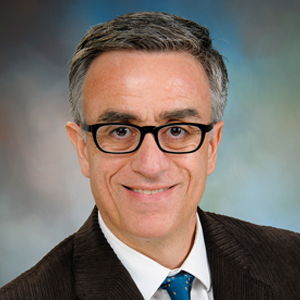What, how and why is problem-based learning in medical education?
Problem-based learning, or PBL, is a pedagogical practice employed in many medical schools. While there are numerous variants of the technique, the approach includes the presentation of an applied problem to a small group of students who engage in discussion over several sessions. A facilitator, sometimes called a tutor, provides supportive guidance for the students. The discussions of the problem are structured to enable students to create conceptual models to explain the problem presented in the case. As the students discover the limits of their knowledge, they identify learning issues – essentially questions they cannot answer from their fund of knowledge. Between meetings of the group, learners research their learning issues and share results at the next meeting of the group.
.jpg)
How do faculty members participate in this process?
Faculty members often participate as facilitators. Indeed, the role of the facilitator and the nature of the problem are key to successful implementation. Facilitators must be supportive rather than directive. They ask questions to assist students with identifying the limits of their knowledge, monitor the group process (encouraging participation) and provide a framework for constructing models of understanding. Content expertise on the part of the faculty may be helpful but is not considered necessary for effective facilitation. Deeper understanding of the topic may allow the facilitator to guide student discussions to be more comprehensive. It also may increase the challenge of maintaining a nondirective role. Problems presented in cases are constructed at a level of complexity to activate students’ existing knowledge and require integration and application of new knowledge. Cases contain contextual information so that the patients become more real to the students and therefore more memorable.Why are medical schools incorporating PBL?
PBL has become popular in medical schools that have undergone curriculum reforms incorporating multidisciplinary-system-based courses rather than discipline-specific ones. For example, students may learn biochemistry as it relates to organ systems of the human body while they are solving problems presented in clinical cases. This approach provides relevance, encourages self-directed learning, targets higher-order learning and engages students in ways that result in better long-term retention of content than traditional, lecture-based courses.Can you give me an example of how the process works?
During a traditional, lecture-based system, students learn the basics about the developmental and cell biology of erythrocytes (their lineage, shape, size, absence of nucleus, etc.); the biochemistry of hemoglobin (cofactor requirements, protein quaternary structure, cooperativity and allosterism, etc.); and the various mutations that result in disease states (sickle cell anemias, thalassemias, etc.). When asked about the phenotype of a sickle-cell hemoglobin carrier, a student who learned these concepts in a traditional, lecture-based environment might reply that there is no phenotype, unless the carrier is living in a region with malaria, in which case the carrier may be better able to resist the disease because of heterozygous advantage (classic concepts learned in genetics). However, if a group of students are presented with a case of a patient undergoing a sickle-cell crisis and are prompted to consider the many aspects of the disease, including the implications for family members, they might arrive at a different answer. They may come to the realization that the phenotype of a carrier could include the presence of some elongated cells in a smear of venous blood, particularly after exercise (which appears to occur in the majority of cases). In this manner, knowledge integration leads to critical consideration of how a phenotype is defined and how this indeed can depend on the variable being studied (a concept clearly generalizable beyond the hemoglobinopathies).What student skills should we encourage for PBL-focused medical education?
Self-directed learning: Students who demonstrate adequate performance in PBL activities are capable of applying their knowledge to think critically. They must be trained to be able to use information rather than merely capable of remembering it. Students in PBL-based curricula increase the level of self-direction they bring to learning. The more self-direction they develop as undergraduates, the more likely it is that they will become independent learners as practicing professionals. Lifelong learning uses a set of skills that develop over time and require practice.Reflection: Some of the critical skills can be encouraged and practiced in college classes. These include self-assessment, group learning and active learning. Students need opportunities to identify their strengths and weaknesses and figure out what it is that they do not know or thoroughly understand. They need to be encouraged to ask good questions. By encouraging students in formulating good questions, we empower them to identify their knowledge gaps.
Teamwork: Students also must develop skills necessary for learning in groups. They must be able to learn from peers and teach peers, moving readily between those roles. They need to be able to assist each other in integrating and applying knowledge to a given problem. These skills are acquired through active learning. Projects and lab work often promote these skills.
In summary, students need opportunities to assess their knowledge, identify and remedy knowledge gaps, and integrate and apply knowledge to real-world problems as part of a team.
Enjoy reading ASBMB Today?
Become a member to receive the print edition four times a year and the digital edition monthly.
Learn moreFeatured jobs
from the ASBMB career center
Get the latest from ASBMB Today
Enter your email address, and we’ll send you a weekly email with recent articles, interviews and more.
Latest in Careers
Careers highlights or most popular articles

Building the blueprint to block HIV
Wesley Sundquist will present his work on the HIV capsid and revolutionary drug, Lenacapavir, at the ASBMB Annual Meeting, March 7–10, in Maryland.

Upcoming opportunities
Present your research alongside other outstanding scientists. The #ASBMB26 late-breaking abstract deadline is Jan. 15.

Designing life’s building blocks with AI
Tanja Kortemme, a professor at the University of California, San Francisco, will discuss her research using computational biology to engineer proteins at the 2026 ASBMB Annual Meeting.

Upcoming opportunities
#ASBMB26 late-breaking abstract submission opens on December 8. Register by Jan. 15 to get the early rate on our Annual Meeting.

Make your abstract stand out
Ensure your research is impossible to overlook. Get quick, practical reminders for crafting an abstract that attracts readers and helps you build connections at the conference.

Inside industry postdocs
As more Ph.D. scientists look beyond academia, industry postdocs offer a new kind of training, where mentorship meets mission-driven research. Fellows at Pfizer and Genentech share how these programs prepare them to translate discovery into impact.


